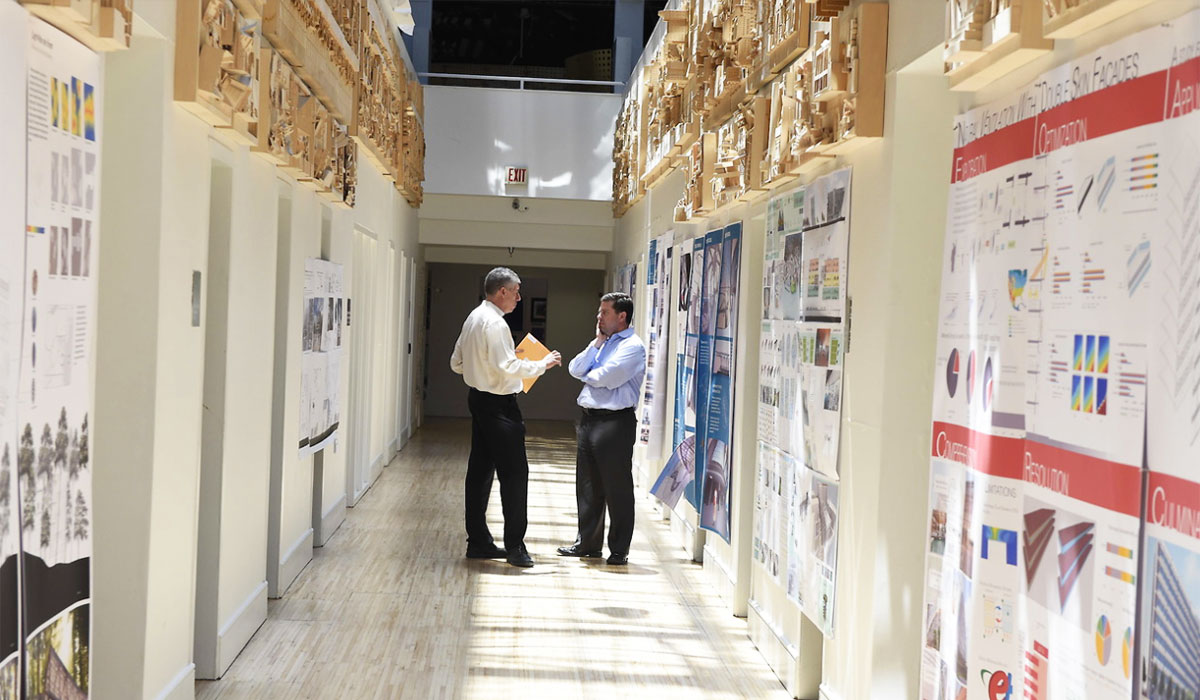Good architecture reflects God and elevates the human person — allowing us to love, flourish, and be part of something greater than ourselves. How and what we build instructs future generations on how we faced our toughest challenges – like unbridled consumerism, extreme climate change, systemic social injustice and beyond. At the Architecture School at the Catholic University of America (CUA), we pledge ourselves and our students to a higher cause.
Our buildings are more than just concrete and wood. Through co-creation, buildings and structures exhibit a beauty and knowledge of the Creator and physically connect people with each other. It is no accident that for thousands of years philosophers have compared the soul to the city. A well-made city, town, neighborhood or building should model excellence and give every individual the highest likelihood to become their best self.
When we design or erect a building, we must first ask how that structure serves its purpose. Is it charitable? Is it just? Does it safeguard creation, protect the least among us, and bring about a greater good for all? At CUA, we challenge our students to exercise their integrity and their craft to build cities where people come first.
We Value:
-
1. Acquiring and advancing foundational knowledge in architecture.
We educate those who will design, build, and conserve the built environment. Utilizing its remarkable location in the nation’s capital, our school provides an enriching educational climate in which students investigate foundational knowledge in the science, history, and language of buildings, and their application to the design of human habitation. -
2. Accepting responsibility to serve the common good.
As a school within the national university of the Catholic Church in the United States, our principles are critically informed by Catholic social doctrine. We teach the architect’s ethical value to society and the architect’s responsibility to serve the common good. These principles are present throughout our curriculum and help foster students who ask a question that challenges the world: “what ought we to do?” Our relationships with each other are intimately tied to the physical locations we share and it is essential to seek the good if we are to build for good. The Catholic faith also provides a robust and profound intellectual framework for these important considerations not only for those who practice the Catholic faith but for all people. We welcome people of all walks of life, different faiths and diversities of thought to contribute to this journey towards truth and true community. -
3. The joy of acquiring, preserving, creating and sharing knowledge.
It is our job to form virtuous architects who not only learn from the past but create new knowledge. Humility is an awareness of things as they truly are. Listening, understanding, and gaining wisdom from those before us helps us build a more harmonious world. Architects must earn the trust of their neighbors by both conserving and renewing the culture they inherit. In that continuity we are able to produce great visionaries who pursue the common good and solve our great challenges. We must nurture curiosity, critical thinking, discipline, collaboration, empathy, and leadership. -
4. An essential Catholic liberal arts education.
It is easy to get lost in learning professional skills and lose sight of the human dimension. By pursuing a true liberal arts education, our students aspire to excellence and develop virtue. As Vitruvius wisely states, “the architect should be equipped with knowledge of many branches of study and varied kinds of learning.” From the oldest surviving treatise on architecture — that architecture is useful, well-built, and beautiful — to the lessons of St. Thomas Aquinas — that beauty is wholeness, proportionality, and radiance. We don’t just want to train great architects. We want to form leaders. Our goal is to create good people who, armed with faith and reason, leave our school with the tools to build a better world. -
5. An aim to create, build, and protect God’s gift to us: our planet.
We are at a critical moment in the human condition. We must strive to build sustainable, practical, and equitable communities for everyone, not just the powerful. Architecture’s first aim should be the good of mankind. Our environment is our home and, as Pope Francis explains in Laudato Si, if we cannot love our home planet, how can we expect to love each other? We teach how individual buildings fit together to make safe, environmentally resilient, and person-centric neighborhoods. The current trend is unsustainable. We must respond by creating walkable, human-scale, public places where all people feel they belong and can build a legacy for ages to come. -
6. Nurturing a diverse community of people who care for each other.
At Catholic University, we recognize that each person is a uniquely created being and our aim is to provide a formative and challenging education that makes each man and woman better versions of themselves. We put faith in our students to bring their best work to bear and we focus on creating lasting relationships and lifelong friendships. Our faculty’s expansive research, scholarship, and practice provides abundant opportunities for mentorship. In turn, our students learn to understand the perennial needs for human habitation: the need for safety, the need for a home, and the need to belong to a community. Students learn to value the importance of mutual respect for diverse peoples, life journeys, and cultures – which engender a tolerance, compassion, and inclusivity for people to live full, dignified lives together. -
7. A commitment to beauty and a person-centered world.
At CUA, we want to create an architectural revolution that embodies luminous hopefulness and pours light onto the world. Here, teamwork and collaboration are critical skill sets required to negotiate the public and private dimensions of human flourishing. It is the job of an architect to connect individuals with their community and act as stewards of the places where people live. Architecture is a civic act – a collaboration among many architects, past, present and future who steward the world’s physical resources for the true, good, and beautiful.
-

Crough Center for Architectural Studies and Technology
Our award winning facilities are housed in the original university gymnasium and provide a classic example of adaptive re-use at its best. The School for Architecture and Planning offers a wide variety of resources within our building, the Edward M. Crough Center for Architectural Studies
Learn More
Dean's Welcome

The practice of architecture transcends space and time. As a discipline, it is multi-faceted, complex, and compelling. The ancient Roman architect Vitruvius wrote that good architecture exhibits firmness (shelter from the elements), commodity (accommodation of the occupant’s needs), and delight (beauty). This definition remains as relevant today as it was in ages past.
Cultural, political, and economic forces shape society. Architects use the language of architecture to give tangible form to these forces. Buildings define places, convey identity, provide a sense of belonging, and connect individuals to their surroundings and to each other. Good architecture brings security, freedom, beauty, and joy. Sound architectural design sustains the sanctity of cities.
At Catholic University’s School of Architecture and Planning, the faculty are charged with preparing students to embark on an educational journey sparked by investigation and fueled with imagination. The School teaches the practice of architecture with rigor, curiosity, and compassion. In doing so, we seek to launch new stewards of the places we live with tools that will allow mastery of their craft and foster a lifetime of continued learning.
Mastering the skills necessary for creating buildings involves learning history, theory, construction practices, and design methods. This process will enable you to develop the critical and synthetic thinking required to forge your artistic imagination.
You will be taught how to research ideas, analyze sites, develop designs, and communicate three dimensional building forms through manual and digital diagrams, sketches, drawings, and models. To ensure that your work is accessible to others, you will present and defend your work in private tutorials and public reviews.
The School’s faculty provide an open forum to explore a variety of aesthetic approaches to design. This will encourage you to develop a cosmopolitan outlook; to find common values in multiple aesthetics; and to achieve fluency in the language of the communities in which you are invited to build.
Washington, DC serves as our history classroom and design laboratory. Firsthand study of buildings, neighborhoods, public spaces, and the urban framework that connects them provides essential insight into how cities are the embodiment of cultural, political, and economic forces.
The world as we find it is incomplete, sometimes confused, and often broken. Architects have the opportunity to serve the public realm with the buildings they design, which can help make neighborhoods just, sustainable, and beautiful. In this respect, architects can serve as citizens in their practice by crafting places that, as works of civic art, contribute to the common good.
You will inherit the work of all architects who precede you. Much of it deserves to be admired and emulated. Some of it deserves to be challenged, rejected and reimagined. At the School, we encourage inquiry and debate as we decide what to preserve, repurpose, and replace. As you investigate past architectural achievements, you will discover how associations with other buildings, made appropriately and artistically, imbue new buildings with distinction and meaning.
If you are drawn to the arts, have a capacity to visualize form in your mind’s eye, and enjoy tactile learning, consider visiting Catholic University’s School of Architecture and Planning. In the spirit of CUA’s mission of service, we hope to show you how the time-honored discipline of architecture can help make the world more just, humane, and beautiful.
Mark Ferguson, Dean
